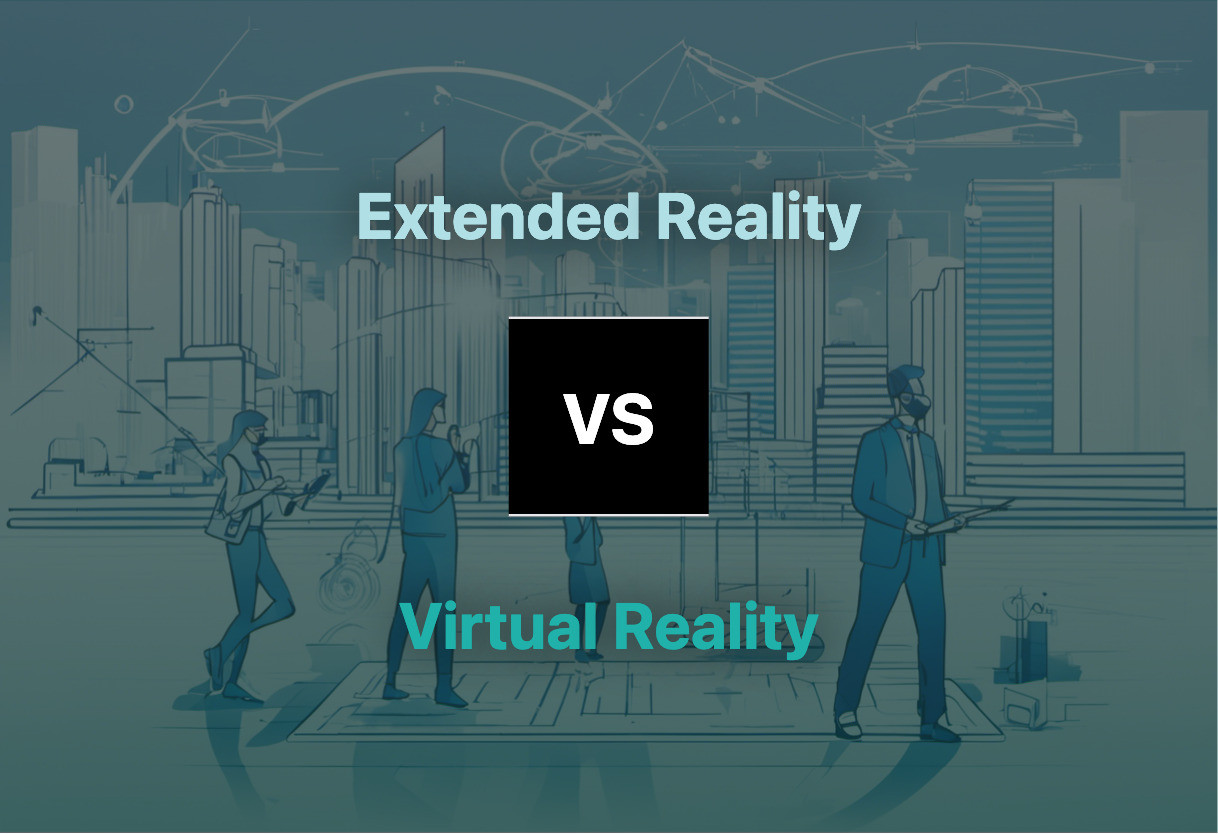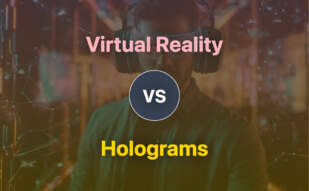When comparing Extended Reality (XR) vs Virtual Reality (VR), XR offers a broader technology horizon, integrating VR, AR and MR. This makes XR more applicable across diverse industries such as gaming, healthcare, and education. However, for specific immersive experiences, VR holds a stronghold, particularly in flight simulation and game development. Final preference hinges on your specific utilization context.

Key Differences Between Extended Reality and Virtual Reality
- Scope: XR integrates VR, AR, and MR, offering a wider technological spectrum, while VR focuses on immersive digital simulations.
- Applications: XR applications extend across diverse sectors like gaming, healthcare, education, military, while VR is typically used in gaming, flight simulators, and remote viewing.
- Interactivity: XR incorporates interactive digital elements in real-world environments, while VR creates an immersive, entirely digital environment.
- Challenges: XR faces interoperability and privacy challenges, as well as high costs and user comfort, while VR’s key hurdles lie mainly in achieving comprehensive sensory stimulation.
| Comparison | Extended Reality (XR) | Virtual Reality (VR) |
|---|---|---|
| Origins | Concepts dating back to 1800s with “stereopsis or binocular vision” | Roots in the 1800s, practical application from the era of photography |
| Applications | Heavily employed in industries like gaming, education, healthcare and the creative economy | Mainly focused on gaming, multimedia experiences with some applications in military and aviation |
| Investment Forecast | Predicted to reach $18.8 billion spending in 2020 | Significant boost from Facebook’s $2 billion purchase of Oculus VR in 2014 |
| Drawbacks | High costs, user comfort, need for dedicated content development, interoperability, and privacy concerns | Limited to predominantly viewing experiences, lacking full immersion; high expense for high-quality head-mounted displays |
| Privacy & Ethics | Potential data privacy issues and ethical concerns regarding usage | User data privacy amongst primary concerns due to nature of immersive experience |
| Potential Impacts | Promises to revolutionize workplaces, improve collaboration, and drive the creation of a network of interconnected realities – the metaverse | Developments hint at creation of fully immersive simulations with broader realities |
| Future Predictions | Growth expected due to increased demand from sectors like military, healthcare, education, and Apple’s initiation with Vision Pro | Significant growth in immersive experiences and simulations expected driven by advancements in head-mounted display technology |
What Is Extended Reality (XR) and Who’s It For?
Extended Reality (XR), comprising Augmented Reality (AR), Virtual Reality (VR), and Mixed Reality (MR), is a versatile technology that finds its application across various industries. Its origins can be traced back to the 1800s concept of “stereopsis or binocular vision”. XR is heavily implemented in industries including gaming, education, and healthcare among others, with spending on XR products predicted to reach $18.8 billion in 2020.
This technology is intended for anyone and any industry looking to leverage the interactive digital elements it avails. Businesses like Ford, DHL, and Boeing are already realizing its benefits in production line optimization, order efficiency, and process simplification.

Pros of Extended Reality (XR)
- Revolutionizes sectors like gaming, education, and healthcare
- Facilitates inclusive decision-making and increased collaboration
- Optimizes production lines and business processes
Cons of Extended Reality (XR)
- High costs of implementation and technological development
- Challenges with user comfort and content development
- Interoperability and privacy concerns
What Is Virtual Reality (VR) and Who’s It For?
Virtual Reality (VR) dates back to the roots of the 1800s practical photography era and gained prominence in the mid-1980s pioneered by VPL Research founder Jaron Lanier. Used to simulate real-world environments, VR has found application in many fields including military, education, and gaming.
VR is for those seeking immersive fully digital simulations. Military personnel, pilots, and even gamers have benefited from this technology to provide unique interaction capabilities.

Pros of Virtual Reality (VR)
- Allows for immersive, fully digital simulations
- Promotes remote viewing to navigate hazardous situations
- Sparked innovations in other tech fields
Cons of Virtual Reality (VR)
- High costs of VR headsets and associated technology
- Accessibility and use restricted to specific sectors
- Can create a sense of disconnectedness from the real world
Extended Reality vs Virtual Reality: Pricing
The financial landscape underlying Extended Reality and Virtual Reality showcases a hard-hitting contrast – XR finds its station on the higher pinnacle of the price scale, while VR straddles impressive affordability with high-end alternatives.
Extended Reality
Extended Reality (XR) amalgamates Virtual Reality (VR), Augmented Reality (AR), and Mixed Reality (MR) into a single bucket, giving rise to an extensive spectrum of immersive experiences. The real-world price tags hovering over this technology tend to scale up considerably. In 2020, estimated spending on XR products and services hit a whopping $18.8 billion. Factors attributing to these skyrocketing prices often stem from multiple-facet integrations within the technology and recurrent research & development exercises to drive the frontiers of XR. Further, creating content for XR that resonates with real-world interfaces comes with its fair share of challenges, including high costs. The price range might spike even more with big players like Apple delving deep into the XR ocean with bespoke solutions.
Virtual Reality
The journey of Virtual Reality (VR), unlike XR, spans over nearly two centuries and incorporates various affordable and premium price points. The budget-friendly offering achieves its embodiment in Google Cardboard, giving users a taste of VR for virtually pennies. However, with technological advancements, there emerge top-tier devices, such as Oculus Rift, fusion of immersive experiences, a 90-degree field of vision and cutting-edge hardware – making them premium offerings with a price to match. The acquisition of Oculus VR by Facebook in 2014 for $2 billion underlines the high stakes and associated costs in the VR domain. However, the pricing in this realm varies significantly depending on the depth of immersion, sophistication of hardware, and fidelity of experiences offered.
The Decisive Verdict: XR vs VR
Extended Reality (XR) and Virtual Reality (VR) – both Titans of Tech. But which prevails?
For Game Makers
Choice: XR. The VR market is maturing, but XR’s burgeoning applications across AR, VR, and MR offers a fertile playing field. Plus, the entry of tech giants like Apple signifies game-changing investments in XR. Seize the narrative – mould the metaverse.Become the XR pioneer.

Education Specialists
Choice: XR. Engagement is key in learning. XR allows educational experiences to be immersive, interactive, and layered with relevance. VR shines too, but remains isolated within its digital realm. With XR’s broader scope, educational possibilities become boundless.

Tech Enthusiasts
Choice: Both. XR invites a multifaceted exploration of technology’s edges, whereas VR whisks enthusiasts into a purely virtual world. VR is traditional escapism. XR is experimental blend. Tech thrills occur in both realms. Dive into both diversions.

If you’re a creative spearhead, game changer, or a tech enthusiast thirsting for the edge, XR solicits exploration. For immersive purists seeking an alternate universe, VR stands unchallenged. Choose wisely, pioneers.
Patrick Daugherty
Content writer @ Aircada. Merging AR expertise with a love for late-night gaming sessions.





